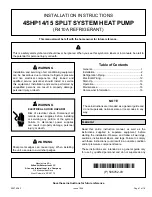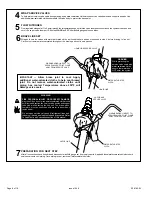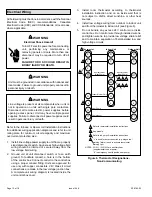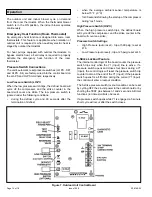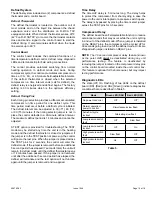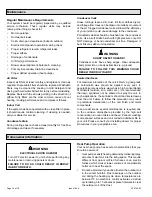
Page 15 of 18
506762-03
Issue 1946
Defrost System
The defrost system includes two (2) components: a defrost
thermostat and a control board.
Defrost Thermostat
The defrost thermostat is located on the outdoor coil of
most models and on the liquid line between the check/
expansion valve and the distributor on R-410A TXV
equipped models. When defrost thermostat senses 29°F
(42°F on R-410A TXV’s) or cooler, the thermostat contacts
close and send a signal to the control board to start the
defrost timing. It also terminates defrost when the liquid
line warms up to 60°F.
Control Board
The control board includes the combined functions of a
time/temperature defrost control, defrost relay, diagnostic
LEDs and terminal strip for field wiring connections.
The control provides automatic switching from normal
heating operation to defrost mode and back. During
compressor cycle, the control accumulates compressor run
times at 30-, 60-, or 90-minute field-adjustable intervals.
If the defrost thermostat is closed when the selected
compressor run time interval ends (call for defrost), the
defrost relay is energized and defrost begins. The factory
setting is 90 minutes which is the optimum efficiency
setting.
Defrost Timing Pins
Each timing pin selection provides a different accumulated
compressor run time period for one defrost cycle. This
time period must occur before a defrost cycle is initiated.
The defrost interval can be adjusted to 30 (/T1), 60 (T2),
or 90 (T3) minutes. If the timing selector jumper is not in
place the control defaults to a 90-minute defrost interval.
The maximum defrost period is 14 minutes and cannot be
adjusted.
A TEST option is provided for troubleshooting. The TEST
mode may be started any time the unit is in the heating
mode and the defrost thermostat is closed or jumpered. If
the jumper is in the TEST position at power-up, the control
will ignore the test pins. When the jumper is placed across
the TEST pins for 2 seconds, the control will enter the
defrost mode. If the jumper is removed before an additional
5 second period has elapsed (7 seconds total), the unit will
remain in defrost mode until the defrost thermostat opens
or 14 minutes have passed. If the jumper is not removed
until after the additional 5 second period has elapsed, the
defrost will terminate and the test option will not function
again until the jumper is removed and re-applied.
Time Delay
The timed-off delay is 5 minutes long. The delay helps
to protect the compressor from short-cycling in case the
power to the unit is interrupted or a pressure switch opens.
The delay is bypassed by placing the timer select jumper
across the TEST pins for 0.5 seconds.
Compressor Delay
The defrost board has a field-selectable function to reduce
occasional sounds that may occur while the unit is cycling
in and out of the defrost mode. When a jumper is installed
on the DELAY pins, the compressor will be cycled off for
30 seconds going in and out of the defrost mode. Units are
shipped with jumper installed on DELAY pins.
NOTE:
The 30 second compressor delay feature (known
as the quiet shift)
must
be deactivated during any unit
performance testing. The feature is deactivated by
removing the jumper located on the compressor delay pins
on the control board mounted inside the unit control box.
This feature is optional for the homeowner, but may impact
testing performance.
Diagnostic LEDs
The state (Off, On, Flashing) of two LEDs on the defrost
board (DS1 [Red] and DS2 [Green]) indicate diagnostics
conditions that are described in Table 5.
Mode
Green LED (DS2)
Red LED (DS1)
No power to control
Off
Off
Normal operation /
power to control
Simultaneous slow flash
Anti-short cycle
lockout
Alternating slow flash
Low pressure switch
fault
Off
Slow flash
Low pressure switch
lockout
Off
On
High pressure switch
fault
Slow flash
Off
High pressure switch
lockout
On
Off
Table 5.

